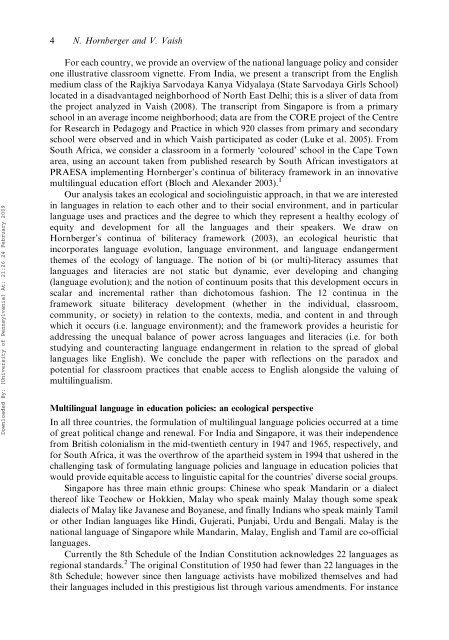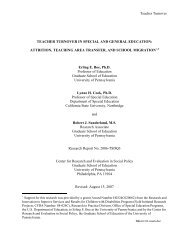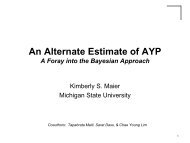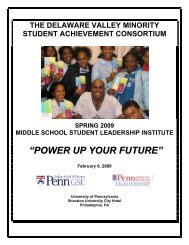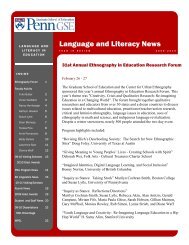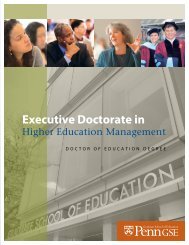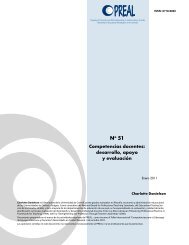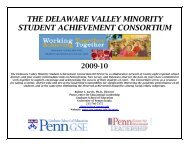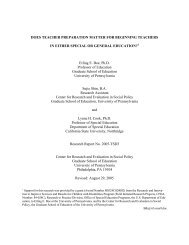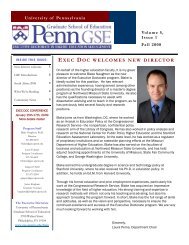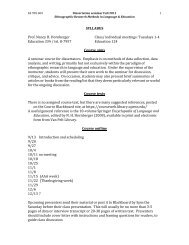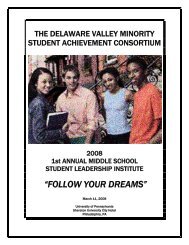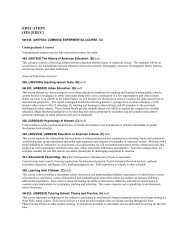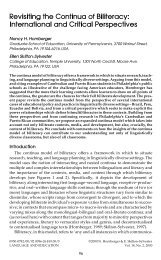Multilingual language policy and school linguistic practice
Multilingual language policy and school linguistic practice
Multilingual language policy and school linguistic practice
Create successful ePaper yourself
Turn your PDF publications into a flip-book with our unique Google optimized e-Paper software.
4 N. Hornberger <strong>and</strong> V. Vaish<br />
Downloaded By: [University of Pennsylvania] At: 21:26 24 February 2009<br />
For each country, we provide an overview of the national <strong>language</strong> <strong>policy</strong> <strong>and</strong> consider<br />
one illustrative classroom vignette. From India, we present a transcript from the English<br />
medium class of the Rajkiya Sarvodaya Kanya Vidyalaya (State Sarvodaya Girls School)<br />
located in a disadvantaged neighborhood of North East Delhi; this is a sliver of data from<br />
the project analyzed in Vaish (2008). The transcript from Singapore is from a primary<br />
<strong>school</strong> in an average income neighborhood; data are from the CORE project of the Centre<br />
for Research in Pedagogy <strong>and</strong> Practice in which 920 classes from primary <strong>and</strong> secondary<br />
<strong>school</strong> were observed <strong>and</strong> in which Vaish participated as coder (Luke et al. 2005). From<br />
South Africa, we consider a classroom in a formerly ‘coloured’ <strong>school</strong> in the Cape Town<br />
area, using an account taken from published research by South African investigators at<br />
PRAESA implementing Hornberger’s continua of biliteracy framework in an innovative<br />
multilingual education effort (Bloch <strong>and</strong> Alex<strong>and</strong>er 2003). 1<br />
Our analysis takes an ecological <strong>and</strong> socio<strong>linguistic</strong> approach, in that we are interested<br />
in <strong>language</strong>s in relation to each other <strong>and</strong> to their social environment, <strong>and</strong> in particular<br />
<strong>language</strong> uses <strong>and</strong> <strong>practice</strong>s <strong>and</strong> the degree to which they represent a healthy ecology of<br />
equity <strong>and</strong> development for all the <strong>language</strong>s <strong>and</strong> their speakers. We draw on<br />
Hornberger’s continua of biliteracy framework (2003), an ecological heuristic that<br />
incorporates <strong>language</strong> evolution, <strong>language</strong> environment, <strong>and</strong> <strong>language</strong> endangerment<br />
themes of the ecology of <strong>language</strong>. The notion of bi (or multi)-literacy assumes that<br />
<strong>language</strong>s <strong>and</strong> literacies are not static but dynamic, ever developing <strong>and</strong> changing<br />
(<strong>language</strong> evolution); <strong>and</strong> the notion of continuum posits that this development occurs in<br />
scalar <strong>and</strong> incremental rather than dichotomous fashion. The 12 continua in the<br />
framework situate biliteracy development (whether in the individual, classroom,<br />
community, or society) in relation to the contexts, media, <strong>and</strong> content in <strong>and</strong> through<br />
which it occurs (i.e. <strong>language</strong> environment); <strong>and</strong> the framework provides a heuristic for<br />
addressing the unequal balance of power across <strong>language</strong>s <strong>and</strong> literacies (i.e. for both<br />
studying <strong>and</strong> counteracting <strong>language</strong> endangerment in relation to the spread of global<br />
<strong>language</strong>s like English). We conclude the paper with reflections on the paradox <strong>and</strong><br />
potential for classroom <strong>practice</strong>s that enable access to English alongside the valuing of<br />
multilingualism.<br />
<strong>Multilingual</strong> <strong>language</strong> in education policies: an ecological perspective<br />
In all three countries, the formulation of multilingual <strong>language</strong> policies occurred at a time<br />
of great political change <strong>and</strong> renewal. For India <strong>and</strong> Singapore, it was their independence<br />
from British colonialism in the mid-twentieth century in 1947 <strong>and</strong> 1965, respectively, <strong>and</strong><br />
for South Africa, it was the overthrow of the apartheid system in 1994 that ushered in the<br />
challenging task of formulating <strong>language</strong> policies <strong>and</strong> <strong>language</strong> in education policies that<br />
would provide equitable access to <strong>linguistic</strong> capital for the countries’ diverse social groups.<br />
Singapore has three main ethnic groups: Chinese who speak M<strong>and</strong>arin or a dialect<br />
thereof like Teochew or Hokkien, Malay who speak mainly Malay though some speak<br />
dialects of Malay like Javanese <strong>and</strong> Boyanese, <strong>and</strong> finally Indians who speak mainly Tamil<br />
or other Indian <strong>language</strong>s like Hindi, Gujerati, Punjabi, Urdu <strong>and</strong> Bengali. Malay is the<br />
national <strong>language</strong> of Singapore while M<strong>and</strong>arin, Malay, English <strong>and</strong> Tamil are co-official<br />
<strong>language</strong>s.<br />
Currently the 8th Schedule of the Indian Constitution acknowledges 22 <strong>language</strong>s as<br />
regional st<strong>and</strong>ards. 2 The original Constitution of 1950 had fewer than 22 <strong>language</strong>s in the<br />
8th Schedule; however since then <strong>language</strong> activists have mobilized themselves <strong>and</strong> had<br />
their <strong>language</strong>s included in this prestigious list through various amendments. For instance


